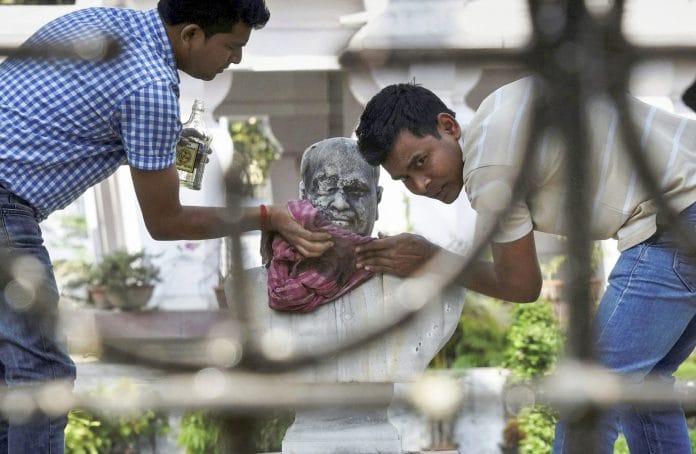Mukherjee had differences with Hindu Mahasabha after the assassination of Mahatma Gandhi and he eventually quit to form Jana Sangh, BJP’s predecessor.
New Delhi: A bust of Jana Sangh founder Shyama Prasad Mukherjee was vandalised in Kolkata recently in what was seen as a reaction to the pulling down of Lenin’s statue in Tripura by BJP supporters.
The Kolkata police tweeted Wednesday that seven people were arrested in this connection.
Who was Shyama Prasad Mukherjee?
Mukherjee founded the Bharatiya Jana Sangh, which later transformed into Bharatiya Janata Party (BJP), the current ruling party at the Centre.
Born in Kolkata, Mukherjee had studied law at Lincoln’s Inn in England. He became a barrister and soon after, the youngest vice-chancellor of Calcutta University.
It is at Calcutta University that Mukherjee’s political life began to take shape. In 1929, he entered the Bengal Legislative Council as an Indian National Congress candidate representing his university. However, he had some differences with the Congress and resigned from the party a year later.
In 1939, Mukherjee joined the Hindu Mahasabha and became its acting president. He strongly backed the idea of Partition and wrote a letter to then governor general Lord Mountbatten in 1947 saying that there must be a division of Bengal even if the rest of India remained united. Mukherjee wanted to ensure all the Hindu-majority areas came to India.
He, along with the Hindu Mahasabha, boycotted the Quit India Movement. “The administration of the province should be carried on in such a manner that in spite of the best efforts of the Congress, this movement will fail to take root in the province,” he wrote.
Back in Congress fold
After Independence, however, Mukherjee joined Jawaharlal Nehru’s interim cabinet. He became the minister of industry and supply.
Mukherjee was having problems with the Hindu Mahasabha as well, which he eventually quit. The latter did not accept his proposal to induct non-Hindu members into the organisation and he had differences with them after the assassination of Gandhi.
Problems soon arose with Nehru too, and Mukherjee along with K.C. Neogy resigned from the Nehru-led cabinet in 1950.
Birth of Jana Sangh
It is at this juncture that Mukherjee founded the Bharatiya Jana Sangh, in 1951. The party propagated Hindu nationalism and was seen as the political arm of the RSS.
Mukherjee also protested against the special status for Jammu and Kashmir as guaranteed by the Constitution. He also led a hunger strike to protest against a law that prohibited Indians from settling in Kashmir. He was arrested while trying to cross into Kashmir illegally, and in 1953 he mysteriously died in detention.
Nehru later said that there was nothing mysterious about his death and no investigation committee was set up.
Conspiracy theory
In 2004, then prime minister Atal Bihari Vajpayee claimed that Mukherjee’s arrest and death were part of a conspiracy hatched by Nehru. Vajpayee went on to say that Mukherjee was the reason why J&K was still a part of India.






